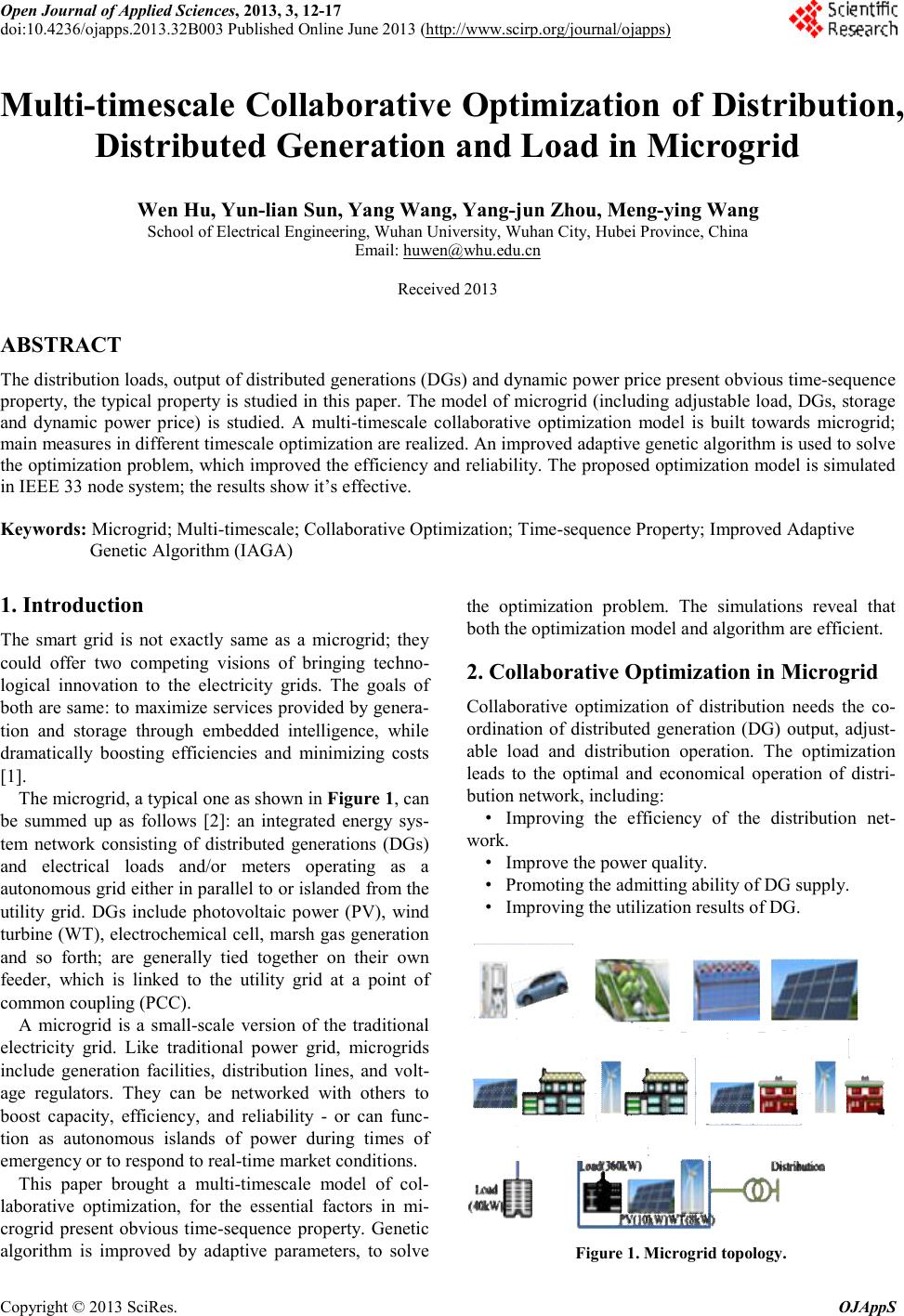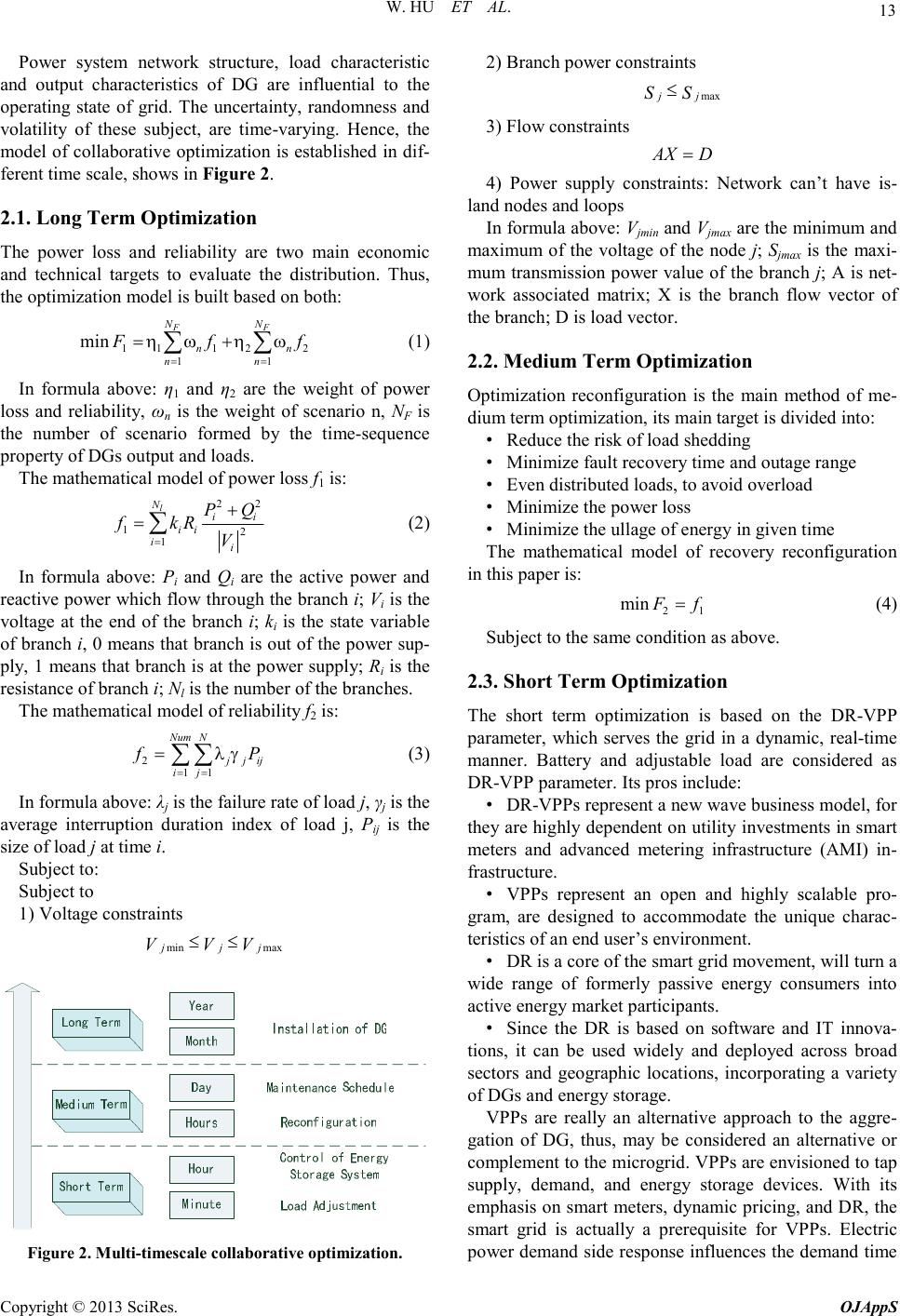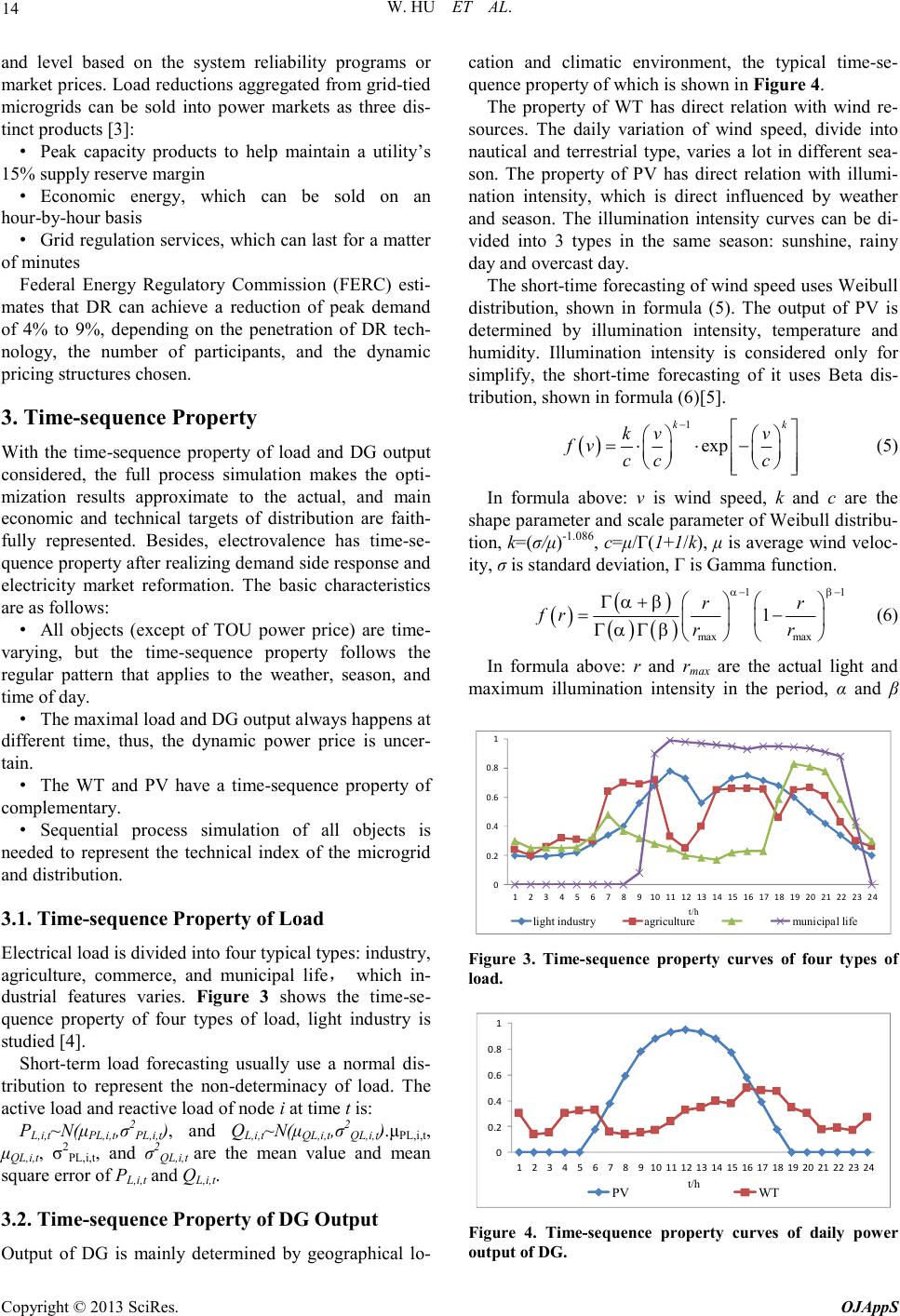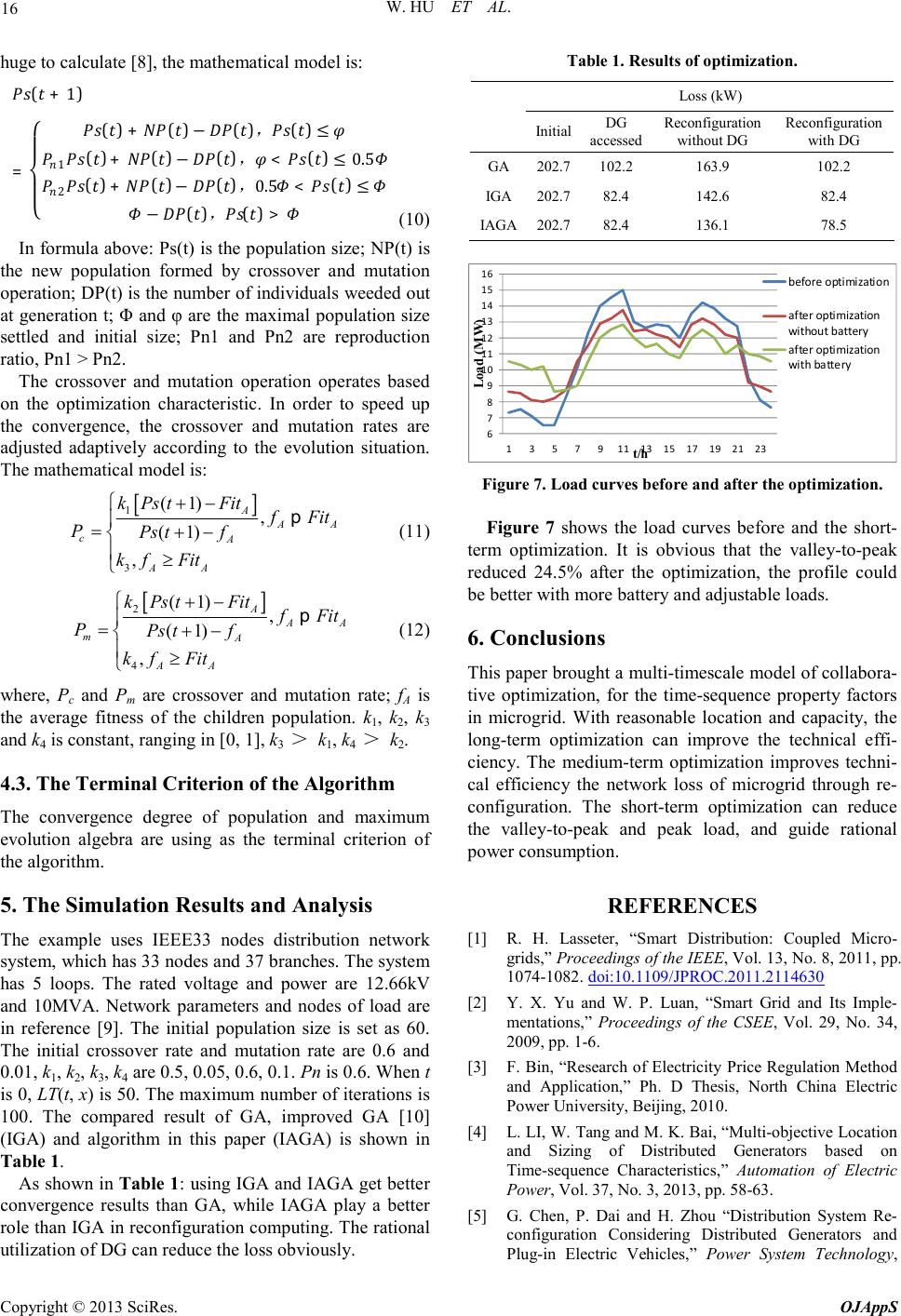 Open Journal of Applied Sciences, 2013, 3, 12-17 doi:10.4236/ojapps.2013.32B003 Published Online June 2013 (http://www.scirp.org/journal/ojapps) Copyright © 2013 SciRes. OJAppS Multi-timescale Collaborative Optimization of Distribution, Distributed Generation and Load in Microgrid Wen Hu, Yun-lian Sun, Yang Wang, Yang-jun Zhou, Meng-ying Wang School of Electrical Engineering, Wuhan University, Wuhan City, Hubei Province, China Email: huwen@whu.edu.cn Received 2013 ABSTRACT The distribution loads, output of distributed generations (DGs) and dynamic power price present obvious time-sequence property, the typical property is studied in this paper. The model of microgrid (including adjustable load, DGs, storage and dynamic power price) is studied. A multi-timescale collaborative optimization model is built towards microgrid; main measures in different timescale optimization are realized. An improved adaptive genetic algorithm is used to solve the optimization problem, which improved the efficiency and reliability. The proposed optimization model is simulated in IEEE 33 node system; the results show it’s effective. Keywords: Microgrid; Multi-timescale; Collaborative Optimization; Time-sequence Property; Improved Adaptive Genetic Algorithm (IAGA) 1. Introduction The smart grid is not exactly same as a microgrid; they could offer two competing visions of bringing techno- logical innovation to the electricity grids. The goals of both are same: to maximize services provided by genera- tion and storage through embedded intelligence, while dramatically boosting efficiencies and minimizing costs [1]. The microgrid, a typical one as shown in Figure 1, can be summed up as follows [2]: an integrated energy sys- tem network consisting of distributed generations (DGs) and electrical loads and/or meters operating as a autonomous grid either in parallel to or islanded from the utility grid. DGs include photovoltaic power (PV), wind turbine (WT), electrochemical cell, marsh gas generation and so forth; are generally tied together on their own feeder, which is linked to the utility grid at a point of common coupling (PCC). A microgrid is a small-scale version of the traditional electricity grid. Like traditional power grid, microgrids include generation facilities, distribution lines, and volt- age regulators. They can be networked with others to boost capacity, efficiency, and reliability - or can func- tion as autonomous islands of power during times of emergency or to respond to real-time market conditions. This paper brought a multi-timescale model of col- laborative optimization, for the essential factors in mi- crogrid present obvious time-sequence property. Genetic algorithm is improved by adaptive parameters, to solve the optimization problem. The simulations reveal that both the optimization model and algorithm are efficient. 2. Collaborative Optimization in Microgrid Collaborative optimization of distribution needs the co- ordination of distributed generation (DG) output, adjust- able load and distribution operation. The optimization leads to the optimal and economical operation of distri- bution network, including: • Improving the efficiency of the distribution net- work. • Improve the power quality. • Promoting the admitting ability of DG supply. • Improving the utilization results of DG. Figure 1. Microgrid topology.  W. HU ET AL. Copyright © 2013 SciRes. OJAppS 13 Power system network structure, load characteristic and output characteristics of DG are influential to the operating state of grid. The uncertainty, randomness and volatility of these subject, are time-varying. Hence, the model of collaborative optimization is established in dif- ferent time scale, shows in Figure 2. 2.1. Long Term Optimization The power loss and reliability are two main economic and technical targets to evaluate the distribution. Thus, the optimization model is built based on both: 11 min FF NN nn nn ηωηω == =+ ∑∑ (1) In formula above: η1 and η2 are the weight of power loss and reliability, ωn is the weight of scenario n, NF is the number of scenario formed by the time-sequence property of DGs output and loads. The mathematical model of power loss f1 is: 12 1 l N ii ii fkR V = + =∑ (2) In formula above: Pi and Qi are the active power and reactive power which flow through the branch i; Vi is the voltage at the end of the branch i; ki is the state variable of branch i, 0 means that branch is out of the power sup- ply, 1 means that branch is at the power supply; Ri is the resistance of branch i; Nl is the number of the branches. The mathematical model of reliability f2 is: 211 NumN ij λγ == = ∑∑ (3) In formula above: λj is the failure rate of load j, γj is the average interruption duration index of load j, Pij is the size of load j at time i. Subject to: Subject to 1) Voltage constraints jjj VVV Figure 2. Multi-timescale collaborative optimization. 2) Branch power constraints jj SS 3) Flow constraints 4) Power supply constraints: Network can’t have is- land nodes and loops In formula above: Vjmin and Vjmax are the minimum and maximum of the voltage of the node j; Sjmax is the maxi- mum transmission power value of the branch j; A is net- work associated matrix; X is the branch flow vector of the branch; D is load vector. 2.2. Medium Term Optimization Optimization reconfiguration is the main method of me- dium term optimization, its main target is divided into: • Reduce the risk of load shedding • Minimize fault recovery time and outage range • Even distributed loads, to avoid overload • Minimize the power loss • Minimize the ullage of energy in given time The mathematical model of recovery reconfiguration in this paper is: min (4) Subject to the same condition as above. 2.3. Short Term Optimization The short term optimization is based on the DR-VPP parameter, which serves the grid in a dynamic, real-time manner. Battery and adjustable load are considered as DR-VPP parameter. Its pros include: • DR-VPPs represent a new wave business model, for they are highly dependent on utility investments in smart meters and advanced metering infrastructure (AMI) in- frastructure. • VPPs represent an open and highly scalable pro- gram, are designed to accommodate the unique charac- teristics of an end user’s environment. • DR is a core of the smart grid movement, will turn a wide range of formerly passive energy consumers into active energy market participants. • Since the DR is based on software and IT innova- tions, it can be used widely and deployed across broad sectors and geographic locations, incorporating a variety of DGs and energy storage. VPPs are really an alternative approach to the aggre- gation of DG, thus, may be considered an alternative or complement to the microgrid. VPPs are envisioned to tap supply, demand, and energy storage devices. With its emphasis on smart meters, dynamic pricing, and DR, the smart grid is actually a prerequisite for VPPs. Electric power demand side response influences the demand time  W. HU ET AL. Copyright © 2013 SciRes. OJAppS 14 and level based on the system reliability programs or market prices. Load reductions aggregated from grid-tied microgrids can be sold into power markets as three dis- tinct products [3]: • Peak capacity products to help maintain a utility’s 15% supply reserve margin • Economic energy, which can be sold on an hour-by-hour basis • Grid regulation services, which can last for a matter of minutes Federal Energy Regulatory Commission (FERC) esti- mates that DR can achieve a reduction of peak demand of 4% to 9%, depending on the penetration of DR tech- nology, the number of participants, and the dynamic pricing structures chosen. 3. Time-sequence Property With the time-sequence property of load and DG output considered, the full process simulation makes the opti- mization results approximate to the actual, and main economic and technical targets of distribution are faith- fully represented. Besides, electrovalence has time-se- quence property after realizing demand side response and electricity market reformation. The basic characteristics are as follows: • All objects (except of TOU power price) are time- varying, but the time-sequence property follows the regular pattern that applies to the weather, season, and time of day. • The maximal load and DG output always happens at different time, thus, the dynamic power price is uncer- tain. • The WT and PV have a time-sequence property of complementary. • Sequential process simulation of all objects is needed to represent the technical index of the microgrid and distribution. 3.1. Time-sequence Property of Load Electrical load is divided into four typical types: industry, agriculture, commerce, and municipal life , which in- dustrial features varies. Figure 3 shows the time-se- quence property of four types of load, light industry is studied [4]. Short-term load forecasting usually use a normal dis- tribution to represent the non-determinacy of load. The active load and reactive load of node i at time t is: PL,i,t~N(μPL,i,t,σ2PL,i,t), and QL,i,t~N(μQL,i,t,σ2QL,i,t).μPL,i,t, μQL,i,t, σ2PL,i,t, and σ2QL,i,t are the mean value and mean square error of PL,i,t and QL,i,t. 3.2. Time-sequence Property of DG Output Output of DG is mainly determined by geographical lo- cation and climatic environment, the typical time-se- quence property of which is shown in Figure 4. The property of WT has direct relation with wind re- sources. The daily variation of wind speed, divide into nautical and terrestrial type, varies a lot in different sea- son. The property of PV has direct relation with illumi- nation intensity, which is direct influenced by weather and season. The illumination intensity curves can be di- vided into 3 types in the same season: sunshine, rainy day and overcast day. The short-time forecasting of wind speed uses Weibull distribution, shown in formula (5). The output of PV is determined by illumination intensity, temperature and humidity. Illumination intensity is considered only for simplify, the short-time forecasting of it uses Beta dis- tribution, shown in formula (6)[5]. () 1 exp kvv fv ccc − =⋅⋅− (5) In formula above: v is wind speed, k and c are the shape parameter and scale parameter of Weibull distribu- tion, k=(σ/μ)-1.086, c=μ/Γ(1+1/k), μ is average wind veloc- ity, σ is standard deviation, Γ is Gamma function. () ( ) () ( ) maxmax 1 rr fr rr αβ αβ αβ Γ+ =− ΓΓ (6) In formula above: r and rmax are the actual light and maximum illumination intensity in the period, α and β 0 0.2 0.4 0.6 0.8 1 1 2 3 4 56 7 8 9101112131415161718192021222324 t/h light industry agriculture municipal life Figure 3. Time-sequence property curves of four types of load. 0 0.2 0.4 0.6 0.8 1 123456789101112131415161718192021222324 t/h PV WT Figure 4. Time-sequence property curves of daily power output of DG.  W. HU ET AL. Copyright © 2013 SciRes. OJAppS 15 are the shape parameter of Beta distribution which can get by the average value μ and variance σ of illumination intensity. 2 1 µµ αµ σ − (7) ( ) 2 1 µµ βµ σ − (8) 3.3. Time-sequence Property of Electrovalence Time-of-use (TOU) power price [6] and dynamic power price are important measures in demand side response. TOU power price can efficiently reflect electricity pric- ing mechanism of power supply cost in different time- interval. Dynamic power price can accurately reflect the fluctuation of electricity pricing mechanism in every time-interval and realize the optimal allocation of power resources, by linking t market clearing price and sale price of retail side. A typical time-sequence property of both is shown in Figure 5. 4. Improved Adaptive Genetic Algorithm Genetic algorithm (GA) is a kind of optimization algo- rithms, simulates Darwin's genetic choice and natural elimination biology evolution process. GA searches mul- tiple point parameters of the code based on random transformation rules, existing the early convergence and slow convergence. To solve the problem, an improved adaptive genetic algorithm (IAGA) is used. 0 0.3 0.6 0.9 1.2 1.5 123456789101112131415161718192021222324 t/h dynamic power price TOU power price Figure 5. Time-sequence property curves of electrovalence. { { { { { { { { { { { { 1 1 11 1 DGDGi DGDGi LLL MOM LLL Figure 6. Chromosome structure. The GA process includes: chromosome encode, the form of the initial population, fitness value evaluation, and genetic operation. 4.1. Chromosome Encode Binary chromosome encoding is used, but varies in the 3 optimization. 1) Long term optimization To locate and size the DGs, the segmented binary chromosome encoding is used: segments represent the number of DG types, each section of the code represent a location and size of a DG. Chromosome, shown in Figure 6, has m segment (means the number of DG types is m); section i means the location and size of DG No.i; Tij means the installa- tion conditions of DG No.i at node j; the capacity of DG is expressed with a 4 bits, which represents heterogene- ous of capacity. 2) Medium term optimization Binary coding based on the loop is used, to shorten the length of chromosome and avoid a large number of in- feasible solutions: • Coding of “0” indicates that the switch is open, Coding of “1” indicates that the switch is closed. • The switch, connects with power source directly, should be closed. 3) Short term optimization Similar with Figure 6, the chromosome has m segment (m means the number of node with battery or adjustable load), Tij means the conditions of No.i at node j (“1” represents forward currents, “0” represents negative or no currents). The form of the initial population in medium term op- timization is based on loop. 4.2. Genetic Operation The age and lifetime of individual [7] are used to avoid population size increasing too fast. The age increases with every genetic algebra. When age reaches the life- time, the individual dies. Lifetime is calculated every generation: (,) (,),(,) (1,) (,) (,),(,) W AW A BA FittxFit FitFit LTtx FittxFit FitFit θ θ − −≤ − += − + − (9) In formula above: = LT(t,x)-age(x); LT(t,x) and Fit(t,x) are the age and lifetime of individual x at genera- tion t; FitB, FitA and FitW are the best, average, worst fit- ness of the individuals of present population; age(x) is the age of individual x. To macro-control the generation in case it being too  W. HU ET AL. Copyright © 2013 SciRes. OJAppS 16 huge to calculate [8], the mathematical model is: = '(())+*+(,)-./(0) , 12(3)45 67189(:)+;<(=)->?(@) , A<BC(D)40.5E , , (10) In formula above: Ps(t) is the population size; NP(t) is the new population formed by crossover and mutation operation; DP(t) is the number of individuals weeded out at generation t; Φ and φ are the maximal population size settled and initial size; Pn1 and Pn2 are reproduction ratio, Pn1 > Pn2. The crossover and mutation operation operates based on the optimization characteristic. In order to speed up the convergence, the crossover and mutation rates are adjusted adaptively according to the evolution situation. The mathematical model is: 1 3 (1) , (1) , A cA AA kPstFit PPstf kfFit +− =+− ≥ p (11) 2 4 (1) , (1) , A mA AA kPstFit PPstf kfFit +− =+− ≥ p (12) where, Pc and Pm are crossover and mutation rate; fA is the average fitness of the children population. k1, k2, k3 and k4 is constant, ranging in [0, 1], k3 > k1, k4 > k2. 4.3. The Terminal Criterion of the Algorithm The convergence degree of population and maximum evolution algebra are using as the terminal criterion of the algorithm. 5. The Simulation Results and Analysis The example uses IEEE33 nodes distribution network system, which has 33 nodes and 37 branches. The system has 5 loops. The rated voltage and power are 12.66kV and 10MVA. Network parameters and nodes of load are in reference [9]. The initial population size is set as 60. The initial crossover rate and mutation rate are 0.6 and 0.01, k1 , k2, k3, k4 are 0.5, 0.05, 0.6, 0.1. Pn is 0.6. When t is 0, LT(t, x) is 50. The maximum number of iterations is 100. The compared result of GA, improved GA [10] (IGA) and algorithm in this paper (IAGA) is shown in Table 1. As shown in Table 1: using IGA and IAGA get better convergence results than GA, while IAGA play a better role than IGA in reconfiguration computing. The rational utilization of DG can reduce the loss obviously. Table 1. Results of optimization. Loss (kW) Initial DG accessed Reconfiguration without DG Reconfiguration with DG GA 202.7 102.2 163.9 102.2 IGA 202.7 82.4 142.6 82.4 IAGA 202.7 82.4 136.1 78.5 6 7 8 9 10 11 12 13 14 15 16 1 3 5 7 91113 15 17 19 21 23 Load (MW) t/h before optimization after optimization without battery after optimization with battery Figure 7. Load curves before and after the optimization. Figure 7 shows the load curves before and the short- term optimization. It is obvious that the valley-to-peak reduced 24.5% after the optimization, the profile could be better with more battery and adjustable loads. 6. Conclusions This paper brought a multi-timescale model of collabora- tive optimization, for the time-sequence property factors in microgrid. With reasonable location and capacity, the long-term optimization can improve the technical effi- ciency. The medium-term optimization improves techni- cal efficiency the network loss of microgrid through re- configuration. The short-term optimization can reduce the valley-to-peak and peak load, and guide rational power consumption. REFERENCES [1] R. H. Lasseter, “Smart Distribution: Coupled Micro- grids,” Proceedings of the IEEE, Vol. 13, No. 8, 2011, pp. 1074-1082. doi:10.1109/JPROC.2011.2114630 [2] Y. X. Yu and W. P. Luan, “Smart Grid and Its Imple- mentations,” Proceedings of the CSEE, Vol. 29, No. 34, 2009, pp. 1-6. [3] F. Bin, “Research of Electricity Price Regulation Method and Application,” Ph. D Thesis, North China Electric Power University, Beijing, 2010. [4] L. LI, W. Tang and M. K. Bai, “Multi-objective Location and Sizing of Distributed Generators based on Time-sequence Characteristics,” Automation of Electric Power, Vol. 37, No. 3, 2013, pp. 58-63. [5] G. Chen, P. Dai and H. Zhou “Distribution System Re- configuration Considering Distributed Generators and Plug-in Electric Vehicles,” Power System Technology,  W. HU ET AL. Copyright © 2013 SciRes. OJAppS 17 Vol. 37, No. 1, 2013, pp. 82-88. [6] J. Li, J. Y. Liu, L. F. Xie, H. Quan and Y. B. Liu, “Dy- namic Game Linkage of TOU Pricing Between Generat- ing Side and Retail Side,” Electric Power Automation Equipment, Vol. 32, No. 4, 2012, pp. 16-19. [7] J. Arabas,Z. Michalewicz and J. Mulawka, “GAVaPS: A Genetic Algorithm with Varying Population Size,” Proceedings of the 1st IEEE Conference on Evolutionary Computation, 1994, pp. 73-78. [8] X. Jin, “The Application of Genetic Algorithm with Adaptive Population Size in Distribution Network,” North China Electric Power University, Beijing, 2011. [9] H. Zhang, “Study of Distribution Network Fault Restora- tion Based on Genetic and Particle Swarm Mixed Algo- rithm,” Wuhan University, Wuhan, 2009. [10] S. Q. Sheng, Z. G. Ma and J. Wu, “Distribution Network Fault Restoration Based on Improved Adaptive Genetic Algorithm,” Second Conference on Intelligent Computa- tion Technology and Automation, 2009.
|